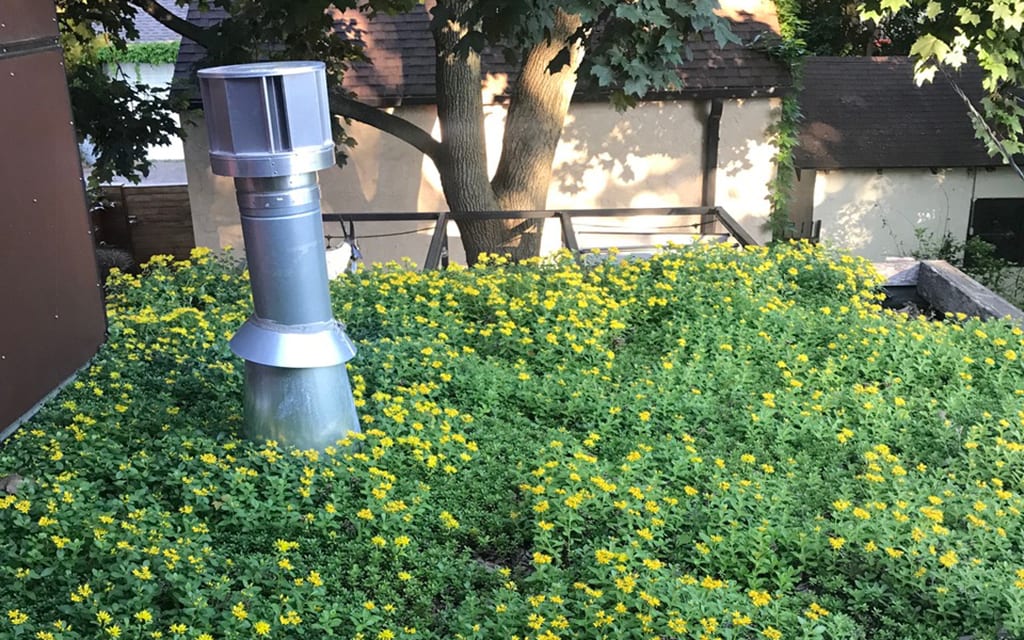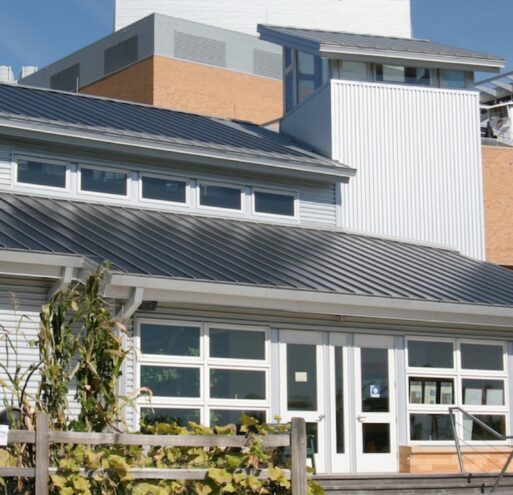
As temperatures creep upward and the calendar advances into late spring, many homeowners are tending to lawns, flower beds and tomato plants. But what about their roofs?
Green roofs, to be exact. Do most owners of these environmentally friendly overhead surfaces need to conduct the kind of seasonal maintenance we associate with other landscaped spaces?
Short answer: No. Green roofs are functional building coverings topped with plant beds rather than shingles or other conventional finishing materials. Their upper layers typically contain sedums and other succulents and native plantings that require little or no mowing or pruning.
In autumn, homeowners might collect a few leaves from a green roof — as they would from their rain gutters. When winter nears, there’s no need to cover a green roof or otherwise protect it from the cold. Sure, it’s important to be aware of snow buildup near windows or other building openings — but that’s the case with any low-sloped roof.
What’s good about a green roof?
While green roofs don’t add much to a homeowner’s to-do list, they can bring several benefits.
- They can capture rainwater and reduce runoff that may pollute nearby lakes and rivers.
- They often absorb less heat than typical dark-colored roofs, which can cut building cooling costs.
- They can take in carbon dioxide and release oxygen, contributing to higher air quality.
- They can provide greenspace and habitat for beneficial birds and insects.
- When visible from inside or outside the building, they can add a distinctive element of beauty.
Should you consider a green roof for your home or business?
That depends. A green roof may cost more than a traditional roofing solution. And it likely calls for a more robust planning process. Green roofs can be heavier than standard roofs, so it’s important to ensure the buildings they sit upon have adequate capacity to support the structural load. That means when implementing this feature, it’s crucial to work with skilled, knowledgeable professionals — such as architects and engineers.
As with any building addition or renovation element, green roofs should function as intended when designed and built with care. If you’re curious about topping off your home or business with a green roof, contact Shelter to discuss the idea.
Where can you see green roofs in your community?
Green roofs are more common in Europe than they are in the U.S. — but in recent years, several high-profile examples have cropped up in Minnesota and Wisconsin.
- Target Center in Minneapolis was the first North American arena to sport a green roof. When installed in 2009, the 2.5-acre covering was Minnesota’s largest green roof — and the fifth-largest in the U.S.
- The R.C. Knox Memorial Garden Green Roof at the St. Paul Fire Headquarters includes a vegetable garden that firefighters use to grow ingredients for meals.
- The Minnesota Landscape Arboretum in Chaska has a green roof on one of its rentable picnic shelters.
- The W.R. Davies Student Center at the University of Wisconsin Eau Claire keeps some pollutants from entering Little Niagara Creek — and helps protect its banks from erosion.
Related Posts
Waste not, want not: embracing material reuse in design
Thoughts from Shelter team member Jakob Mahla Is adaptive reuse the answer? It’s no secret that the buildings that surround…
Read moreSustainable design can serve your cannabis business
When budding cannabis entrepreneurs think green, they often have more than plants and profits in mind. As business owners prepare…
Read more
Science House featured on Minnesota Public Radio
Shelter's Science House featured on MPR's Climate Cast In 2003, The Science Museum of Minnesota and Shelter Architecture finished a…
Read more